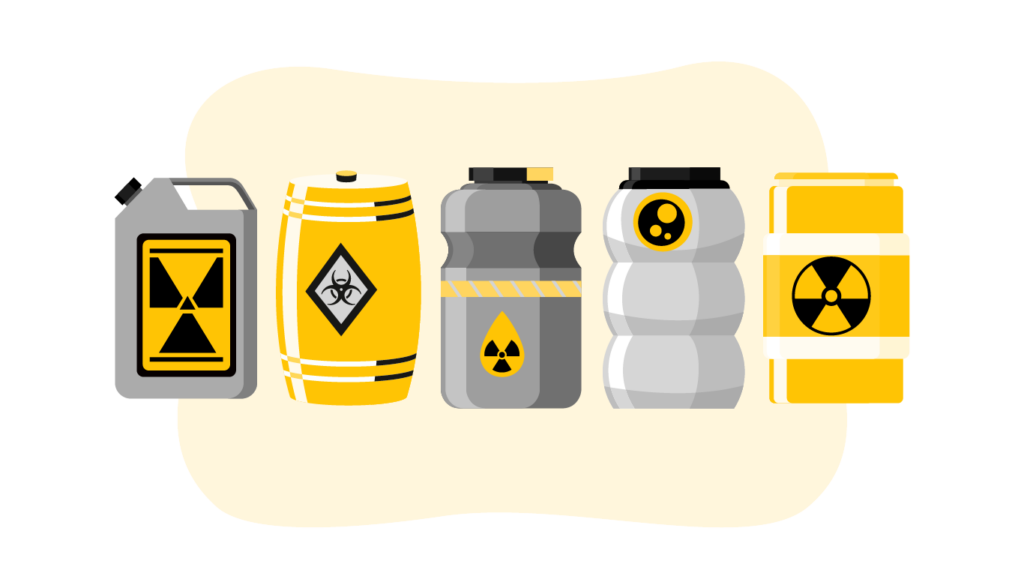Our Most Detailed Hazardous Chemicals Safety Talk

Exposure to hazardous chemicals at the workplace is a common occupational hazard.
Many chemicals that are used in the worksites are dangerous to humans. So, when they are in direct contact, they can enter the body through various body orifices like the skin, nose, eyes, etc. This is why employees must be aware of the chemical exposures they may have at their workplaces, the possible entry routes, and how to protect themselves. In this article, we will talk about the most common routes of entry for hazardous chemicals.
According to the ILO, exposure to hazardous substances claims the lives of almost 1 million workers yearly. The report further stated that about 233,000 deaths are recorded yearly worldwide due to asbestos (a hazardous chemical) exposure at workplaces.
As you can see from these statistics, it’s important to be aware of the dangers of hazardous chemicals and protect yourself against them. Remember, safety first!
Safe lab analyst is the best analyst.

What Are The Common Routes Of Entry Of Hazardous Chemicals?
Hazardous chemicals can penetrate the human body through various orifices. There are four possible routes a chemical or substance could enter the human body: Inhalation, Ingestion, Absorption, or Injection. Employees must understand what these routes are and how to protect themselves.
Inhalation
Inhalation is the most common way hazardous chemicals enter the body. Toxic chemicals in the air go through the nose and mouth and are absorbed into the body system. The inhaled gases spread rapidly through the circulatory system and cause severe damage to the body tissues. The absorption rate and degree of resulting injury depend on how concentrated the chemicals are, their solubility in the body fluids, and the duration of exposure.
Ingestion
Ingestion is another common route through which toxic chemicals get into the body in workplaces. Laboratory chemicals can cause severe health problems if they get into the mouth or are swallowed. And once they get into circulation, they can cause serious damage to the body tissues. Employees are advised never to taste chemicals or pipette liquids with their mouths.
Absorption
The absorption of chemicals can occur when toxic substances get on your skin or your eyes. Usually, skin contact with chemicals is a common cause of chemical injuries. It can result in mild irritation or a severe form of poisoning. When your skin comes into contact with toxic chemicals, a large number of substances are quickly absorbed into the bloodstream and can lead to systemic poisoning.
The major points of entry for chemicals through the skin are the hair, sebaceous, and sweat glands, as well as cuts or abrasions to the outer skin layers. Blood vessels are plentifully present in the follicles and glands, further aiding in the absorption of chemicals into the body.
Another way chemicals are absorbed is through contact with the eyes. Eye contact with chemicals can cause serious eye irritations. Workplace chemicals like strong acids, phenols, alkaline substances, and phenols are all particularly corrosive and can lead to permanent vision loss. Others might cause pain, irritation, or temporary loss of vision.
Injection
Contact with hazardous chemicals through injections is quite rare in workplaces. However, this can happen unintentionally in the chemical lab due to mechanical harm from chemically contaminated sharp objects like glass or metal or when chemicals are handled in syringes.
Now that you know how chemicals can enter your body, you can take steps to protect yourself. When working with hazardous chemicals, always wear proper protective clothing, which includes gloves, masks, and goggles.

Why Is Chemical Safety Important?
Chemical safety is important for employees because it helps to protect them from the dangers of working with hazardous chemicals.
When employees know the most common routes of entry for these chemicals, they can take steps to protect themselves and avoid dangerous situations. In addition, safety talks about chemical safety can help ensure that employees are properly trained to handle and use these chemicals safely.
According to WHO, “Chemical Safety is achieved by undertaking all activities involving chemicals in such a way as to ensure the safety of human health and the environment. It covers all chemicals, natural and manufactured, and the full range of exposure situations from the natural presence of chemicals in the environment to their extraction or synthesis, industrial production, transport use and disposal.”
OSHA Regulations For Hazardous Chemicals
The Occupational Safety and Health Administration (OSHA) is responsible for creating and enforcing regulations for chemical safety in the workplace. These regulations protect workers from exposure to these chemicals.
OSHA’s Hazard Communication Standard (HCS) requires that employers provide employees with information and training on the hazards of working with chemicals. The HCS requires that employers and manufacturers label chemical products with their hazards and sets forth specific requirements for employee training. This includes handling and storing hazardous chemicals safely and recognizing the signs and symptoms of exposure.
In addition, the HCS requires that employers provide employees with Material Safety Data Sheets (MSDS), which contain information on the hazards of chemicals.
Employees are responsible for reading the label and MSDS before working with a chemical, and they are also responsible for following the manufacturer’s instructions for safely using the chemical.
You must familiarize yourself with OSHA’s regulations and safety information if you work with hazardous materials. This will help keep you safe while working.
Hazards associated with Toxic Chemicals
Hazardous chemicals can pose many acute and long-term physical and health risks, including organ damage, cancer, death, and many more.
There are several types of chemical hazards. And although the categories for these chemical hazards vary, many of the hazardous chemical substances fit into more than one of these categories. Let’s examine a few.
Asphyxiants
Chemical asphyxiants prevent the flow and use of oxygen by the blood, depriving the body of oxygen.
Examples: Cyanide, Carbon Monoxide, Carbon Dioxide
Corrosives
When there is direct contact with corrosive chemicals, it results in noticeable and permanent changes to the area. Also, they have the potential to trigger a localized response in the body at the site of contact.
Example: Sulfuric acid
Irritants
Chemicals categorized as irritants can cause injury to a person’s eyes, skin, or respiratory system when in direct contact. The hazards manifest as redness, rashes, inflammation, coughing, or hemorrhaging.
Example: Hydrochloric acids
Carcinogens
These are chemicals that cause cancer, even when present in small amounts. The effects usually do not appear until many years later.
Examples: Benzene, Vinyl Chloride
Sensitizers
OSHA defines a sensitizer as “a chemical that causes a substantial proportion of exposed people or animals to develop an allergic reaction in normal tissue after repeated exposure to the chemical.”
The affected individual will either experience acute or chronic reactions to these toxic chemicals. The disorders can present as swollen airways, lung disease, asthma, and dermatitis in cases of overexposure.
Examples: Latex, Chlorine
Teratogens
Chemical teratogens are hazardous chemicals that affect the normal development of a fetus, resulting in congenital abnormalities, spontaneous abortions, growth retardation, carcinogenesis, and many more.
Examples: Thalidomide, Mercury Compounds
Chemical Safety Toolbox Talk
Thank you for coming to this toolbox talk on hazardous chemicals. This presentation will discuss the most common routes of entry for hazardous chemicals and how to protect ourselves from these dangers.
There are four main ways that hazardous chemicals can enter our bodies: inhalation, ingestion, absorption, and injection. Inhalation is when the chemical enters our lungs through our noses and mouths; ingestion is when the chemical enters our stomachs through foods or drinks; absorption is when the chemical enters our bloodstream through contact with our skin or eyes; injection is when the chemical enters through contact with contaminated sharp objects or syringes.
All these routes of entry can be dangerous, but inhalation is the most dangerous because the chemical can get into our bloodstream quickly and cause health problems.
When working with hazardous chemicals, it is important to wear proper protective equipment, such as gloves, a mask, and goggles. It is also important to keep them away from heat and open flames.
Fire and explosions can happen when hazardous chemicals are mixed. This can be very dangerous and can cause injury or death. So it is important to be aware of the dangers of hazardous chemicals and take precautions to protect ourselves.
There are several illnesses and injuries that hazardous chemicals can cause. Some of these include:
- Chemical burns
- Respiratory problems
- Nausea and Vomiting
- Diarrhea
- Headaches
- Organ Disorders – Liver, Lungs
- Dizziness
- Birth Defects
- Depression
- Death
Questions To Employees
- What are the four main entry routes for hazardous chemicals?
- What is the most dangerous route of exposure of the body to hazardous chemicals?
- What are some common illnesses and injuries related to hazardous chemicals?
- What is the best way to protect oneself from the possibility of exposure to hazardous chemicals?
- What should be done in a fire or explosion involving hazardous chemicals?
- Can hazardous chemicals be mixed safely?
Email Template To Promote Chemical Safety
Hello,
As a safety manager, I must ensure safety in this workplace. One of the ways I do this is by informing employees on how to protect themselves from the dangers of hazardous chemicals.
In this email, I would like to discuss the most common routes of entry for hazardous chemicals and how to protect oneself from these dangers. I would also like to remind employees that fire and explosions can happen when hazardous chemicals are mixed and that it is important to take precautions when working with them.
There are four major routes of entry for hazardous chemicals. They are Inhalation, Injection, Ingestion, and Absorption. Inhalation is when the chemical enters our lungs through our noses and mouths; ingestion is when the chemical enters our stomachs through foods or drinks; absorption is when the chemical enters our bloodstream through contact with our skins or eyes; injection is when the chemical enters through contact with contaminated sharp objects or syringes.
All these routes of entry can be dangerous, but inhalation is the most dangerous because the chemical can get into our bloodstream quickly and cause health problems.
Here are tips to protect yourself and other employees from chemical hazards:
- Employees should ensure they wear Personal Protective Equipment (PPE) when dealing with toxic chemicals. The protective gear should include respiratory protection, gloves, eye protection, and overall chemical protection apparel.
- Work schedules should be rotated to ensure workers are not overexposed to hazardous chemicals.
- Exposure monitoring of workers’ exposures should be conducted.
- There should be proper ventilation and safe work procedures and practices.
- Employees should use a job hazard analysis (JHA), Workplace Hazards & Solutions Worksheet, or some other tool to find chemicals in the workplace and record any special precautions.
- Check the information on necessary safety data sheets (SDSs) or material safety data sheets (MSDSs), as well as product labels if you’re unsure whether a chemical is hazardous. Ask distributors or manufacturers for them if you don’t have an SDS or label.
I hope you will find this information helpful, and please feel free to contact me if you have any questions.
Thank you,
Name
Video on Chemical Safety
Chemical Safety Meme
Conclusion
Hazardous chemicals can be found in many workplaces, and employees must know how to protect themselves from dangers. This article discussed the four main routes of entry for hazardous chemicals and some of the injuries and illnesses that can result from exposure. We have also provided a video on chemical safety, which will give you more information on how to stay safe when working with hazardous chemicals. Thank you for reading, and please feel free to share this article with your team, friends and family.


